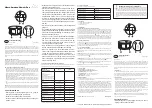
GT-64260A Design Guide
Doc. No. MV-S300165-00, Rev. A
CONFIDENTIAL
Copyright © 2002 Marvell
Page 56
Document Classification: Proprietary Information
May 21, 2002, Preliminary
Note
The device controller does not support bursts longer than 8 bytes for a 16-bit device. Any attempt to
support longer bursts causes the GT-64260A to assert an interrupt. For more information on the interrupt
Section 11, "Interrupt Controller Functional Overview", on page 82
. The following
restrictions are also implied.
–
The CPU must configure the memory space of 16-bit device as uncacheable space.
–
Since the IDMA engines do not support a data transfer limit smaller than 8B, the only DTL allowed from
the IDMA engine to a 16-bit device is 8B.
–
When using MPC745x CPU, the boot device must be 32-bit wide. for more information, see
3.5.1, "MPC745x Burst to Boot Address", on page 21
.
–
It is only possible to read 16-bit devices from a PCI non-prefetchable region.
6.4
32-bit Device
The GT-64260A device controller supports 32-bit wide devices connected on the AD[15:0] bus. The device con-
troller support up to 32 byte bursts to/from 32-bit devices. The burst address is supported by a dedicated three bit
BAdr[2:0] bus, that must be connected directly to the device address bus.
When connecting 2x16-bit devices in parallel to achieve a 32-bit data width, the address pins to both 16-bit
devices must be connected the same as for a 32-bit device. Both devices must be connected to the same CS* and
OE* pins. Connect Wr[1:0] and AD[15:0] to one 16-bit device and connect Wr[3:2] and AD[31:16] to the other 16-
bit device. Use a similar connection for 4x8-bit configuration.
shows the connection of 32-bit wide device to the GT-64260A. For more information on the 32-bit device
connection, see the GT-64260A datasheet’s "Interfacing With 16/16/32-bit Devices" section.
















































